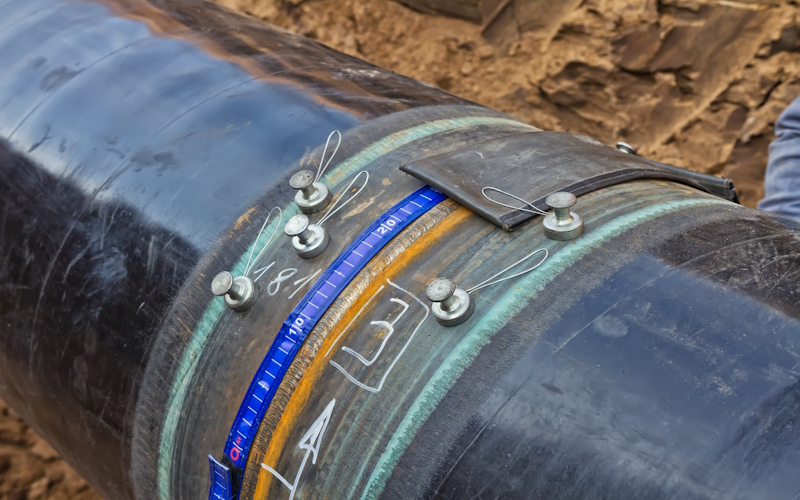Pipeline Welding Inspection: Safeguarding Pipelines with Precision and Proficiency
Wiki Article
Advanced Methods in Pipe Welding Assessment: Advancements and Technologies for Enhanced Accuracy and Integrity in Weld Assessment
The landscape of pipe welding evaluation is undertaking a substantial makeover, driven by sophisticated strategies that assure to boost both precision and reliability in weld assessments. Developments such as automated inspection systems and advanced imaging innovations are redefining traditional methods, while non-destructive testing approaches make sure material honesty is maintained.
Value of Weld Inspection
Making sure the honesty of pipe welds is critical to the overall safety and dependability of industrial systems. Rigorous inspection of welds is integral to the lifecycle of pipeline infrastructure.The significance of weld inspection expands past plain conformity with regulative requirements. It works as a proactive action to identify and correct imperfections, such as incomplete combination, porosity, or fractures, prior to they intensify right into severe problems. Effective inspection techniques also add to the longevity of pipes, lowering maintenance costs and boosting functional effectiveness.
Furthermore, extensive weld inspections foster count on amongst stakeholders, including regulative bodies, capitalists, and the neighborhoods offered by these pipelines. By guaranteeing that all welds meet the called for requirements, companies can alleviate dangers and promote their track records. In summary, weld inspection is vital not just for operational stability however also for the wider effects it holds for safety and security and ecological stewardship.
Automated Assessment Systems
The assimilation of automatic assessment systems in pipe welding has revolutionized the technique to guaranteeing weld high quality and integrity. These systems use advanced robotics and expert system to carry out assessments that are not just faster however likewise more constant than standard techniques. Automated systems can cover comprehensive lengths of pipes effectively, capturing information that human assessors might ignore due to exhaustion or environmental problems.Among the vital benefits of computerized assessment systems is their capability to run in unsafe atmospheres, decreasing the danger to human examiners. They utilize different non-destructive testing (NDT) techniques, such as ultrasonic screening and magnetic fragment assessment, to analyze weld stability without endangering the framework. The information accumulated is refined in real-time, enabling immediate feedback and punctual restorative activities when problems are determined.
Moreover, automated systems facilitate the standardization of evaluation processes, making sure that each weld is assessed against constant standards. This not only improves the dependability of results but also improves compliance with regulatory criteria. As sectors continue to focus on security and operational efficiency, the role of automated inspection systems in pipe welding will definitely broaden, paving the way for extra innovative quality control methodologies.
Advanced Imaging Technologies
Regularly used in contemporary pipeline welding assessments, advanced imaging innovations have actually dramatically boosted the capability to identify and assess weld flaws. Techniques such as digital radiography, computed tomography, and thermographic imaging offer inspectors with high-resolution images that expose sub-surface problems and architectural inconsistencies that might be undetectable to the naked eye.Digital radiography uses electronic sensors to record images, permitting immediate evaluation and boosted image comparison. This brings about faster inspections and improved accuracy in recognizing vital issues. Calculated tomography, on the other hand, provides three-dimensional imaging, enabling examiners to envision complex geometries and assess the integrity of welds from numerous angles - Pipeline Welding Inspection. This deepness of evaluation is very useful for discovering problems that typical techniques may neglect.
Thermographic imaging utilizes infrared innovation to detect variants in temperature, recognizing areas of possible weak point or stress and anxiety within the weld. These innovative imaging technologies not just enhance flaw detection prices yet likewise reduce the moment and resources needed for pipeline examinations. Therefore, they play a critical function in keeping pipeline safety and security and reliability, making certain conformity with market requirements while decreasing operational threats.
Non-Destructive Testing Techniques
Making use of different strategies, non-destructive testing (NDT) approaches are important in pipe welding examinations, enabling the evaluation of weld honesty without compromising the product's architectural honesty. NDT includes a variety of techniques, consisting of ultrasonic screening (UT), radiographic testing (RT), magnetic fragment screening (MT), and dye penetrant screening (PT) Each method has unique benefits and applications depending upon the details needs of the evaluation.
Ultrasonic testing uses high-frequency click here for more info acoustic waves to identify internal problems, providing exact dimensions of weld density and integrity. Pipeline Welding Inspection. Radiographic screening employs X-rays or gamma rays to create pictures of the weld, exposing internal problems that might not show up externally. Magnetic particle testing is efficient for finding surface area and near-surface gaps in ferromagnetic products, while dye penetrant screening highlights surface area cracks by utilizing a colored dye
Integrating these NDT techniques right into pipe welding assessments boosts the precision and reliability of weld analyses, making certain that prospective failings are determined early. As industries demand greater criteria for safety and security and efficiency, the function of NDT in preserving the integrity of bonded frameworks continues to be critical in pipeline building and construction and upkeep.

Future Patterns in Weld Assessment
As we look to the future of weld analysis, improvements in modern technology are poised to reinvent the techniques employed for reviewing pipe honesty. The combination of expert system (AI) and equipment discovering in evaluation processes is expected to enhance the precision of defect discovery and predictive upkeep. These innovations permit real-time information analysis, allowing inspectors to determine possible issues before they intensify into significant issues.Additionally, making use of drones furnished with advanced imaging systems is getting grip. These airborne evaluations can cover substantial areas swiftly, catching high-resolution photos and information that can be evaluated for flaws in hard-to-reach locations. This not just boosts safety however additionally enhances performance in the inspection process.
Moreover, the growth of clever sensors embedded in pipe systems offers the potential for continuous monitoring. These sensors can discover changes in stress, temperature, and vibrations, giving useful insights right into the wellness of the welds with time.

Final Thought
Finally, the combination of advanced strategies in pipe welding inspection considerably other enhances the precision and integrity of weld assessments. Developments such as automated evaluation systems, progressed imaging innovations, and non-destructive screening techniques play an essential role in boosting flaw detection prices and promoting positive maintenance strategies. As these technologies proceed to progress, they will further ensure the safety and performance of pipeline systems, eventually adding to the stability of vital infrastructure.
Report this wiki page